Enab Baladi – Lujain Mourad
“Until this day, we cannot say, may Allah have mercy on him,” Raifa al-Haj Salih said in a soft tone with a trembling voice, describing the state of uncertainty her family has experienced since the kidnapping of her brother Firas by the Islamic State (IS) group in Raqqa. This family fluctuates between hope for his return and despair.
Although it has been about ten years since IS abducted Firas al-Haj Salih, an anti-regime activist in Raqqa, his family is still waiting for any answer to reveal his fate.
Firas’ family is one of the hundreds of families living in endless waiting, while there is no tangible impact of international or local efforts regarding the missing persons’ file and the disclosure of the parties involved in it.
IS left behind a memory full of images of death and dozens of mass graves of its victims and others of the victims of the International Coalition’s operations that affected civilians during the war on the organization.
In late 2022, the Syrian Missing Persons and Forensic Team (SMFT) and the Syria Justice and Accountability Center (SJAC) launched a campaign entitled “Tammnuna” (Reassure Us) to shed light on the file of missing persons in northeastern Syria.
In this file, Enab Baladi discusses some efforts to reveal the fate of the missing persons and the future of hundreds of mass graves in northeastern Syria. It also attempts to measure those efforts’ impact and highlight obstacles to achieving tangible results.
Thousands of victims, Who are involved?
There has been a multitude of successive military forces in control of northeastern Syria. For years, the region was transformed into the “land of the caliphate” in the eyes of IS, while the International Coalition to fight the organization considered it a den of terrorism.
For the people of the region, their villages and cities were transformed into “blackened” spaces, where many memories of death, fear, and ruin hid the bodies of thousands of their loved ones.
Many massacres and graves, the true number of which is not yet known, have made the file of missing persons in those areas one of the most complex files of the conflict in Syria and have left the workers in the field facing a long path of research that requires tremendous efforts.
Despite the multiplicity of parties accused of committing the massacres, the International Coalition and the Islamic State group are the most prominent suspects.
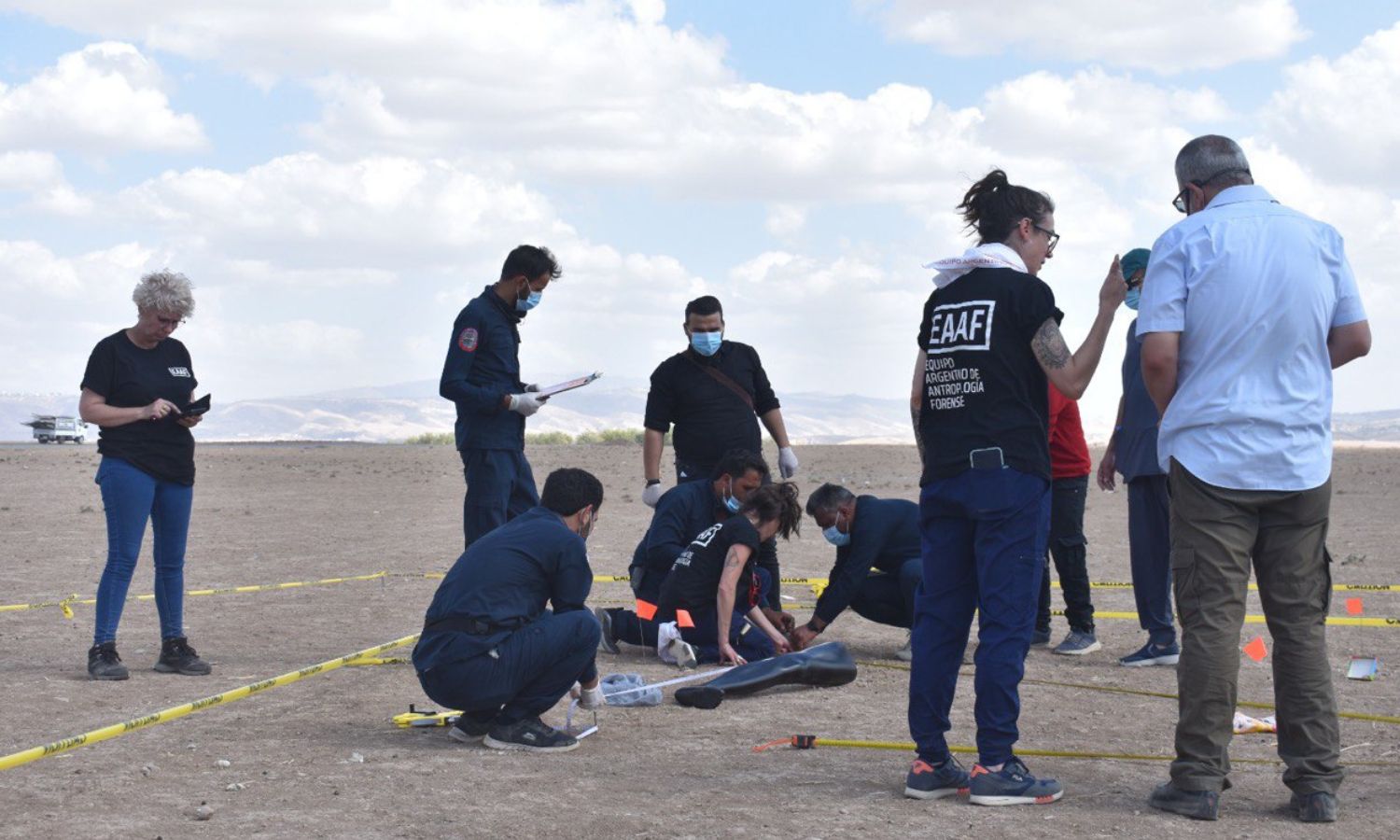
Training for the Syrian Missing Persons and Forensic Team (SMFT) in cooperation with the Argentine Forensic Anthropology Team (EAAF) – October 2022 (Syria Justice and Accountability Center)
Independence, the first of steps
During 2018, talk began of the role of the Initial Response Team of the Autonomous Administration of North and East Syria (AANES), the political umbrella of the Syrian Democratic Forces (SDF), in opening mass graves and searching for missing persons, amid accusations that the team was complicit in blurring the features of the crime.
Despite the team’s efforts during its work under AANES, independence and impartiality was the missing part of its work, as seen by Raqqa-native activist Haitham al-Gharsi, a member of a team that has put forward a project to establish a DNA Bank to reveal the fate of the missing persons.
The activist, formerly a member of the Commission for International Justice and Accountability (CIJA), added that the SDF and the International Coalition were involved in massacres, which required that the work on this file be out of their control.
Considering that independence is the basis for working on the file of the missing persons, the Syria Justice and Accountability Center (SJAC) pushed for the team’s complete independence from AANES.
At the end of 2020, the team became independent and began working under the name “The Syrian Missing Persons and Forensic Team (SMFT).”
The team received training from the Argentine Forensic Anthropology Team (EAAF). Work has also begun on contextual investigations, according to the manager of the project, to reveal the fate of the missing persons at the SJAC, Jumana al-Salman.
|
Because the existing bodies belong to the victims of the various parties to the conflict, this makes the independence of the party working on the missing persons file the first step of action. Jumana al-Salman Manager of the project to reveal the fate of the missing persons at the SJAC |
While work on this file requires “substantial funding,” the team’s dependence on AANES makes it difficult to obtain funding, according to al-Salman. The work also requires that the supervising body be specialized, and AANES does not possess such qualifications.

The Emergency Response Team (ERT) exhumes remains from a mass grave in the city of Raqqa – 16 September 2020 (Raqqa Civil Council/Facebook)
“Emergency” response
Despite some six years of IS’ exit from the region and continuing demands for disclosure of the fate of the missing persons and the identity of thousands of bodies buried under the rubble, work in mass graves remains limited to an “emergency response.”
The project manager at the SJAC said the team was forced to deal with surface graves discovered during infrastructure repairs.
On the mechanism for dealing with those bodies, al-Salman stated that the Syrian Missing Persons and Forensic Team (SMFT) took the bodies for “forensic characterization” by the team’s forensic doctors.
The coroner determines the body’s sex and method of murder, as well as its age and some details that could contribute to identifying it.
Three samples, a hair sample, a femur sample, and another sample from a third place of the body, are taken and kept together with the body’s information and the belongings with which it was buried.
Evidence of violations
Each street in northeastern Syria contains traces of the IS organization’s three-year “caliphate,” during which the region’s landmarks were obliterated and transformed into almost complete ruins of human beings and stone.
The International Coalition participated in destroying the remainder of the region as a result of carrying out airstrikes that did not differentiate between civilians and military personnel during its war on terrorism.
Highlights of that era include prisons where hundreds of civilians were detained and indiscriminate mass graves, along with tales told by the people of the region.
Reaching results that reveal the fate of the missing requires working to cross-reference the information extracted from these evidences, which is what the SMFT is doing.
The SMFT is working on “contextual investigations,” through which it has been able to locate several mass graves and IS prisons, as well as to obtain preliminary information about the bodies buried in some graves, according to the project’s manager at the SJAC, Jumana al-Salman.
|
Contextual investigations: The process of collecting information from various types of witnesses to cross-reference them and identify the locations of mass graves and prisons to narrow the scope of the search for missing persons |
Al-Salman explains that the team worked to gather this information by communicating with the families of missing persons and witnesses, who were divided into four categories:
– Local community;
– Male and female survivors from IS prisons;
– Well-informed witnesses (persons with operational occupations within IS);
– Persons who previously worked in the ranks of the IS and were involved in violations (they served their sentences in AANES prisons or were tried outside Syria, such as the Beatles terrorist cell).
The Syria Justice and Accountability Center (SJAC) shares maps and data showing the locations of prisons it found through witnesses and providing information about those prisons.
Obstacles that prolong families’ suffering
“The file of the missing is a bleeding wound in our hearts, and it will continue to bleed if we do not get answers about the fate of our loved ones.” In those words, Raifa al-Haj Salih described to Enab Baladi the situation of the families of the missing in Syria, including her brother.
Twelve years after the conflict began, Syrian organizations have not ceased to monitor more missing persons, owing to continued abductions, arrests, and enforced disappearances by various parties to the conflict.
The continuation of the conflict and the lack of political stability has also disrupted most of the efforts made in relation to the missing persons’ case, leaving thousands of families living on the remains of hope hanging on the efforts of the organizations.
The director of Syrians for Truth and Justice (STJ), Bassam al-Ahmad, said that political stability was the basis for achieving concrete results by those working on the file of missing persons, especially in the light of the involvement of various parties.
The organizations’ desired efforts include providing answers to families and compensating them, and holding accountable those responsible for their suffering, according to what al-Ahmad told Enab Baladi.
The lack of stability limits the ability of the SMFT to operate, as investigations require continuous training by specialists that the team cannot attend permanently, according to Jumana al-Salman, manager of the project, to reveal the fate of missing persons at the SJAC.
Al-Salman explained that the SMFT members could not travel because they did not have passports. In contrast, specialists fear coming to Syria “for fear of Turkish bombardment and IS sleeper cells.”
Fears of bombing and shifting influence
The SJAC faces many concerns related to the instability of the region, most notably fear for the safety of body samples extracted by the Initial Response Team prior to its partnership with the SJAC, said the project manager, Jumana al-Salman.
This is accompanied by fears for the SMFT members located in the area from shelling, in addition to concern about the shifting map of influence.
The people of the region live with a similar concern that often prevents them from presenting testimonies that can be of great importance in contextual investigations.
Concerns prompt the SJAC to make the safety of the team and that of the witnesses a priority in its work, according to what al-Salman said, indicating that the protection of the team and the local community is a priority.
In efforts to provide such protection, al-Salman said that the SJAC reserved the names of witnesses and sent coordinators to families facing security concerns about moving into the region.
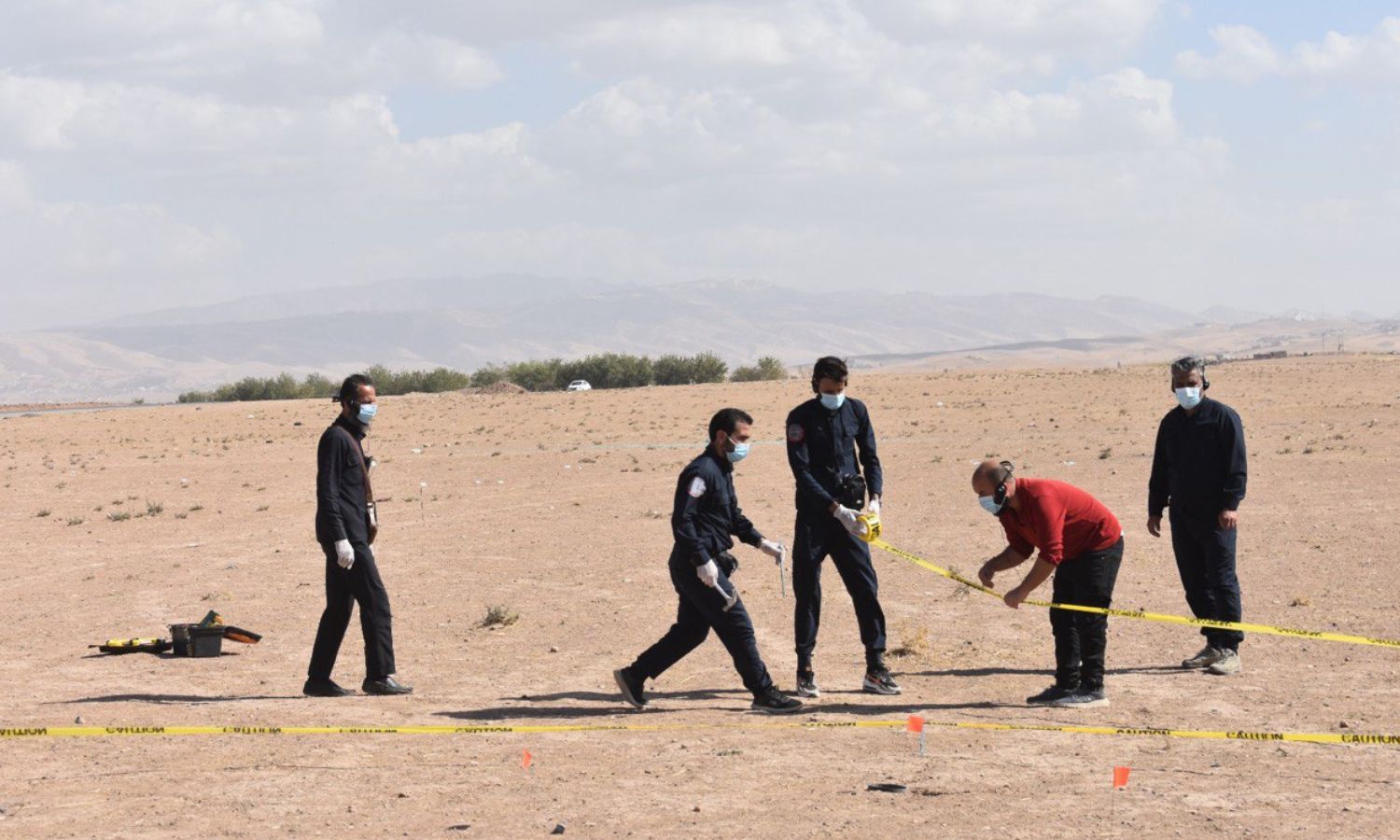
Training for the Syrian Missing Persons and Forensic Team (SMFT) in cooperation with the Argentine Forensic Anthropology Team (EAAF) – October 2022 (Syria Justice and Accountability Centre)
AANES is incapacitated
The case of missing persons in northeastern Syria is linked to the absence of an AANES role, as the latter has not been able to find solutions that contribute to revealing the fate of missing persons.
Raifa al-Haj Salih believes that AANES played a key role in keeping the fate of her brother unknown and contributed to obstructing the file of revealing his fate, especially in light of the presence of dozens of those accused of belonging to IS in its prisons.
The director of Syrians for Truth and Justice (STJ), Bassam al-Ahmad, said that the size and complexity of the file render AANES unable to deal with it properly, considering the solution to be beyond its reach.
As stated by al-Salman, AANES cannot investigate the accused in its prisons due to its inability to conduct the required investigations and prosecute those involved.
Although AANES initially delayed the independence of the Initial Response Team, it did not obstruct its work after it was restructured and trained to be the Syrian Missing Persons and Forensic Team (SMFT).
On the other hand, an International Commission on Missing Persons (ICMP) report in 2020 criticized the absence of AANES efforts in the missing persons’ file.
The report said that AANES did not attempt to interrogate IS fighters detained in its prisons and camps.
According to the report, AANES released IS fighters with the aim of achieving political gains related to the association of combatants with Arab clans in the region, meaning that important information that could reveal the fate of the missing persons could be lost.
A report by the British newspaper The Guardian in November 2021 spoke of the SDF releasing IS-affiliated prisoners in return for money under a “reconciliation” scheme.
According to official documents and interviews conducted by the newspaper with two released fighters, imprisoned Syrian men can pay a fine of 8000 USD to the SDF’s Finance Department in exchange for their release without trial.
On the other hand, the SDF denied what was stated in the report, arguing that the newspaper “fell into the trap of forgery, and the testimonies on which it relied were false.” SDF also continuously announces arrests of persons involved in the smuggling of IS families from its detention camps.
US-led Coalition “not trusted”
The International Coalition, led by the United States of America, admitted its involvement in killing civilians during its military operations against the Islamic State, but its confession partially revealed the truth, as the numbers of civilians it admits to killing are only a small part of those documented by the organizations.
This created doubts over the past years about the credibility of the work of the Emergency Response Team (ERT) funded by the Coalition.
These doubts befell the work of the team even after its independence from the AANES, given that its main funding is still American.
Since the Syria Justice and Accountability Center (SJAC) is mainly registered in the US, it was able, according to the Freedom of Information Act, to compel the US government to provide it with satellite images of cemeteries, and to provide access to the trials of former IS members, according to what the director of the project to reveal the fate of the missing, Jumana al-Salman, said.
For his part, the director of the Syrians for Truth and Justice (STJ) organization, Bassam al-Ahmad, ruled out that the Coalition would obstruct the organizations’ work in the file of the missing, pointing out the need to talk about the Coalition’s victims, and not focus on the IS’ victims only.
International organizations are absent
The role of international organizations in the missing persons’ file was limited to advocacy campaigns and the issuance of periodic reports.
Jumana al-Salman, director of the project to reveal the fate of missing persons at the SJAC, attributed the absence of the role of international organizations to the absence of international recognition of the Autonomous Administration of North and East Syria (AANES).
International organizations do not operate without the approval of the de-facto governments, provided they have international recognition.
In turn, the International Commission on Missing Persons (ICMP) stated that the committee has worked since 2020 to establish and facilitate the work of the Policy Coordination Group for Syria’s Missing and Disappeared (PCG), which is a team that aims to develop general recommendations and a policy framework for a future formal process regarding missing persons in Syria.
The ICMP also worked on conducting training for the formerly Initial Response Team, which focused on protecting mass graves and not tampering with sites that are likely to contain criminal evidence in the future.
According to the organization, it conducted training for organizations working on the file of missing persons in northeastern Syria and provided small grants to Syrian organizations to provide awareness seminars for the families of missing persons in the region.
Indiscriminate work to obliterate evidence?
Since the start of the work of the Initial Response Team in Raqqa in 2018, news and statements have circulated about the team’s discovery of many mass graves.
The team’s work at the time was described as “indiscriminate,” and some attributed its reasons to the team’s desire to obliterate evidence and change the features of the mass graves in order to hide the identity of the real perpetrators, according to civilians from Raqqa governorate interviewed by Enab Baladi.
The former leader of the Initial Response Team, Yasser Khamis, told Enab Baladi that the Initial Response Team was not trained at the beginning of its work and faced many problems as a non-specialist team.
At its beginnings, it was forced to open many graves, due to the presence of corpses buried superficially and in populated places, according to Khamis, who works as head of the Syrian Missing Persons and Forensic Team (SMFT) at the present time.
Khamis attributed the Initial Response Team making many mistakes during that stage to the presence of corpses on the roads and under the rubble, and many families went to exhume graves in search of their loved ones, which forced the team to complete the exhumation operations.
Despite the availability of financial support for the team at the time, there was no training or technical support that could limit mistakes, according to Khamis.
The team does not deny the existence of erroneous or incomplete information in much of the data it collected earlier, according to what the head of the team previously said, considering that the total destruction experienced by the city of Raqqa was enough to search for any way to mitigate the widespread scenes of death.
During the years of work of the Emergency Response Team, many reports from international organizations criticized its indiscriminate work.
In the process of evaluating the file of missing persons in northeastern Syria by the International Commission on Missing Persons (ICMP) in 2020, the organization criticized the team’s “primitive work” in dealing with corpses and attempts to identify them.
The indiscriminate and primitive work resulted in significant damage to the mass graves, which could impede the ability of specialists in the future to identify the bodies.
Khamis said that the previous mistakes could have a negative impact, but their impact is slight, and it can be overcome by developing the work and conducting more training for the Syrian Missing Persons and Forensic Team (SMFT).
Wait is denied
Many families refused to wait for the opportunity to open the graves, and many went to work to open them randomly in search of their missing relatives.
Among the most prominent incidents of the random opening of graves by the people is the al-Shaitat cemetery in the eastern Deir Ezzor province, which contained about 230 bodies.
Jumana al-Salman, director of the project to uncover the fate of missing persons at the SJAC, said that random openings of graves by residents can contribute to concealing evidence and complicate searches for missing persons.
The families’ reliance on the belongings of their children buried with them to determine their identity is not considered a guarantee for that, which means that families may exhume corpses and rebury them in other cemeteries without making sure that they belong to their children, according to al-Salman.
The al-Shaitat cemetery dates back to a massacre committed by IS in mid-August 2014 against the tribesmen of al-Shaitat, which left hundreds dead and dozens missing.
This came after the issuance of a “fatwa” (ruling) by the princes of the Islamic State group to kill males from the region who were over 14 years old, and to confiscate the property of civilians, after accusing the clan of fighting it.
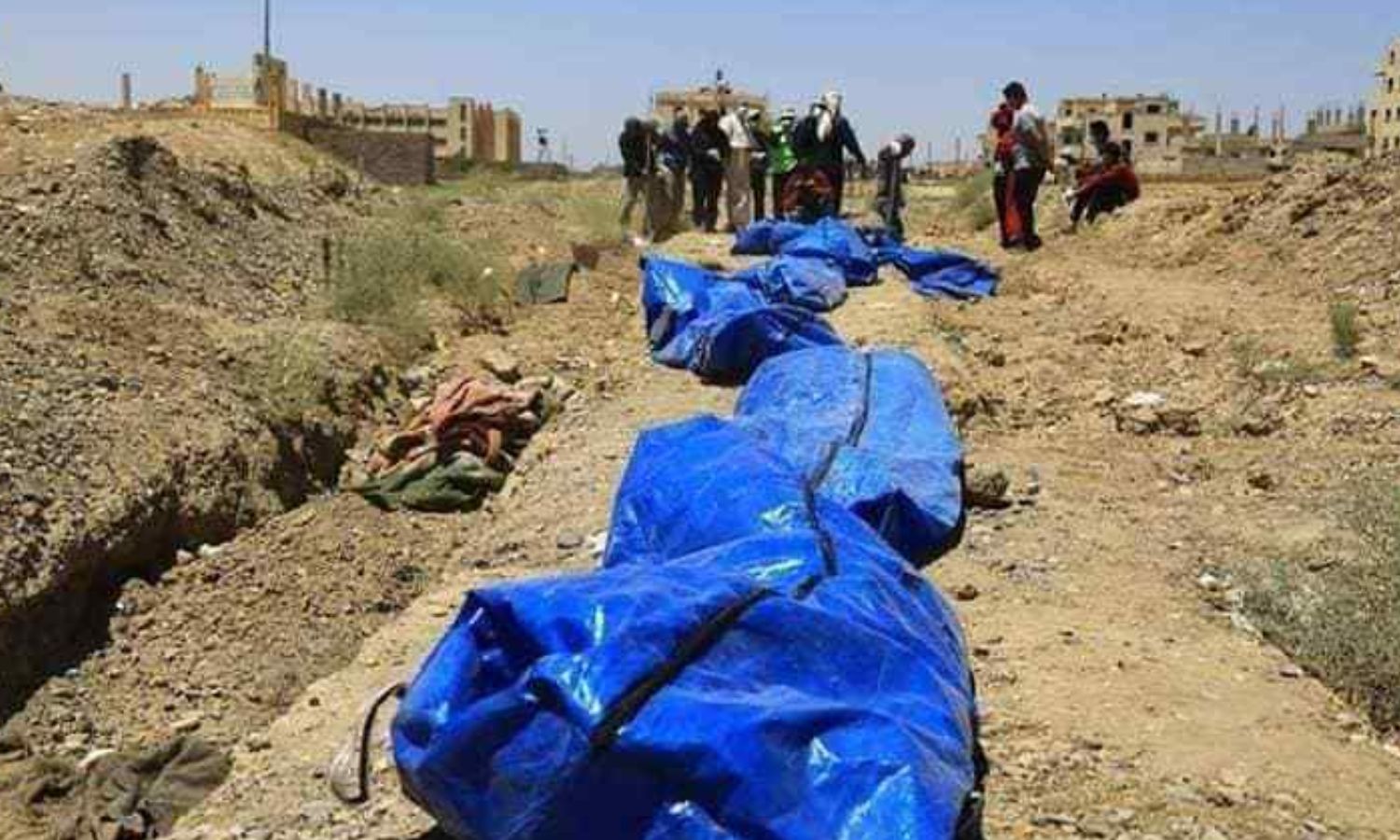
The Emergency Response Team exhumes remains from a mass grave in eastern Raqqa city – 4 March 2019 (Raqqa Civil Council/Facebook)
DNA bank not a solution
In the presence of dozens of mass graves and thousands of missing persons, conducting a DNA analysis is not considered a solution to reveal the fate of the missing, according to the Syrian Justice and Accountability Center (SJAC).
Despite the constant demands of the people to open the graves and conduct analyzes of thousands of corpses and families of the missing, with many projects proposed for this, including the “DNA Bank” project proposed by activists from Raqqa, the organizations did not initiate these procedures.
The SJAC’s administration believes DNA analysis will be at a later stage for contextual investigations, which narrows the scope of research and limits the waste of resources.
The SJAC was not able to reveal the fate of the missing persons until 2023, according to what al-Salman said, pointing out that the work is still in its infancy and may take many years.
The International Commission on Missing Persons (ICMP) said that the organization is seeking, through its work, to pave the way for an advanced stage of work in Syria after reaching a political transition.
The ICMP believes that conducting DNA analysis is the first step in revealing the fate of the missing, pointing out that the Commission’s work on the file of the missing is integrated and includes pushing for justice for the victims and their families.
Revealing the fate of the missing requires solidarity between local and international organizations, according to what the director of the Syrians for Truth and Justice organization, Bassam al-Ahmad, said.
Al-Ahmad believes that the international mechanism for revealing the fate of missing persons in Syria can contribute to this, criticizing the focus during the discussion of the mechanism on the missing persons in the prisons of the Syrian regime and ignoring the rest of the conflict parties.
There has been talk of an independent international humanitarian mechanism concerned with revealing the fate of the forcibly disappeared and detained by the various parties to the conflict in Syria since the High Commissioner for Human Rights, Michelle Bachelet, welcomed, on 8 April, the request of the United Nations in Resolution “76/228”, to obtain a report to study a mechanism to enhance efforts to uncover the fate of missing persons.
In turn, the International Commission on Missing Persons (ICMP) recommends establishing a database of missing persons and supporting cooperation between civil society organizations working in this regard.
The Human Rights Watch (HRW) also made some recommendations to various actors in this regard, most notably:
– Communicating with families inside and outside Syria to ensure they know whom to contact and how regarding their missing relatives.
– Take urgent steps to protect the mass graves, using the necessary forensic expertise to carry out this work effectively.
– Not to transfer any persons previously held by IS, or other individuals in detention, to countries or authorities known to have tortured or ill-treated individuals while in detention.
– Encourage the UN and other international actors to ensure that such support and training are available for this investigation and documentation within a non-discriminatory framework that respects human rights.
if you think the article contain wrong information or you have additional details Send Correction
النسخة العربية من المقال
-
Follow us :













 The Emergency Response Team (ERT) exhumes remains from a mass grave in the city of Raqqa - 28 January 2020 (Raqqa Civil Council/Facebook)
The Emergency Response Team (ERT) exhumes remains from a mass grave in the city of Raqqa - 28 January 2020 (Raqqa Civil Council/Facebook)





 A
A
A
A
A
A
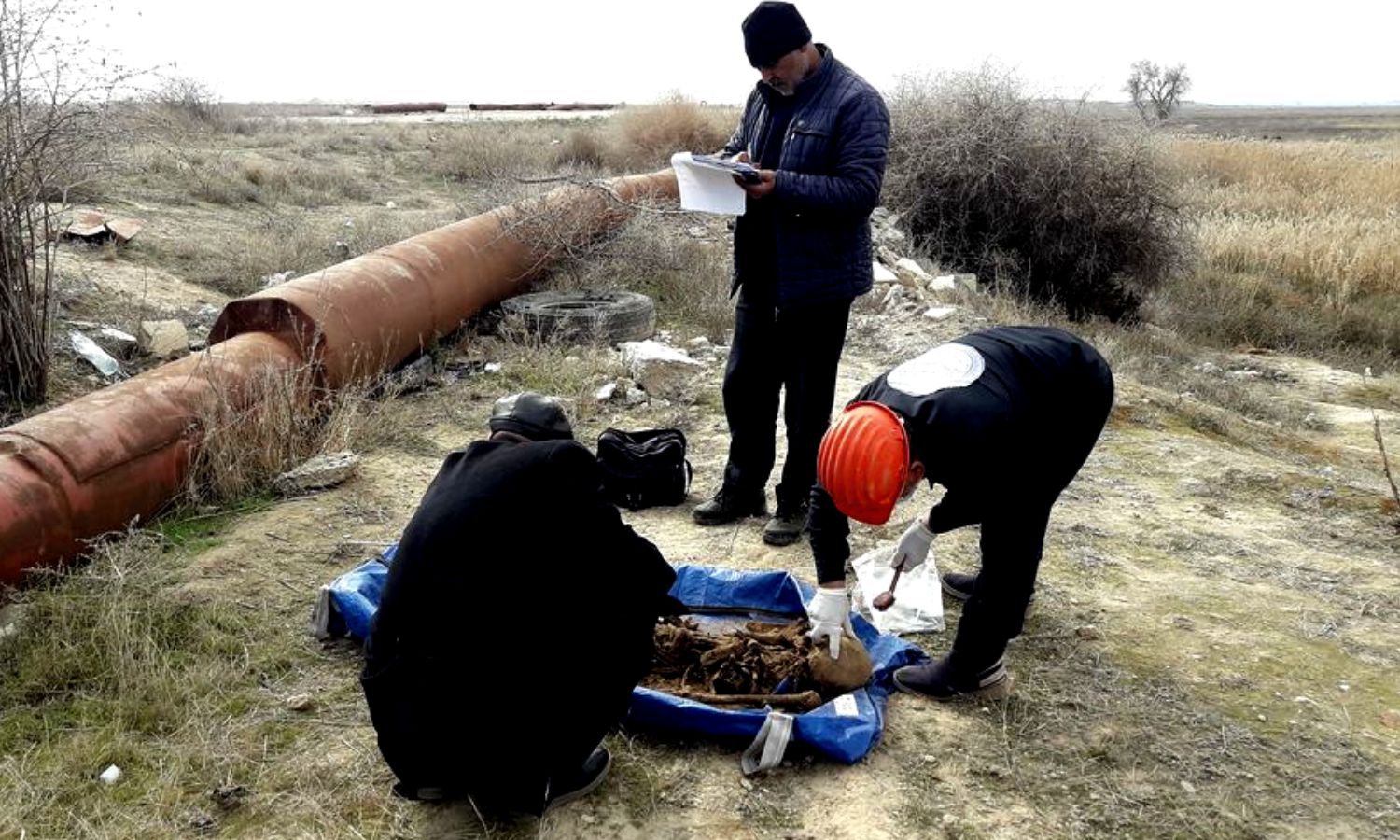







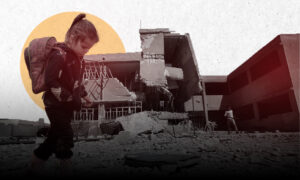
 More In-Depth
More In-Depth